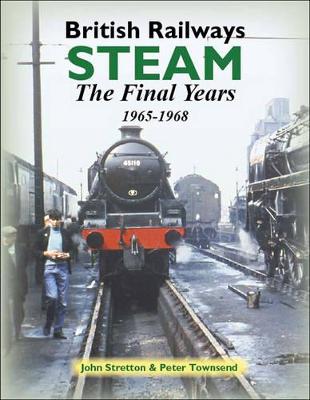Railway Heritage
3 total works
The Fall and Rise of British Railways Steam
by John Stretton and Peter Townsend
Published 24 May 2011
Following the publication of the 1955 Modernisation Plan, which set out to establish the future of Britain's rail network, it seemed that the writing was on the wall for steam traction. With the "Beeching Report" the pace of change gathered speed, and the move to alternative traction was accompanied by considerable contraction of the network. The last steam locomotive built for British Railways, aptly named Evening Star, was outshopped from Swindon Works in 1960, and amazingly the last steam locomotives were withdrawn from service in August 1968! This decline from the mid-1950s forms the first part of this book, as hundreds upon hundreds of locomotives were sent to the breaker's yards. The scrap yards are the sombre location of the second section, which looks at these 'abattoirs of steam', where the vast majority of locomotives were despatched by the cutter's torch all too rapidly. However, among the scenes of devastation something remarkable was happening. Enthusiasts noticed that at one yard, old wagons were being cut up but locomotives were not. This was the remarkable yard of Dai Woodham at Barry Docks in South Wales - locomotives were going to Dai, but not to die!
Thanks in large part to this remarkable man we are able to move to our third section, the preservation years, when locomotives were reserved, then purchased (often gradually) and eventually moved to fledgling preserved lines all over the country to be restored. Having been banned seemingly for ever, steam eventually returned to the main line, and the book concludes with a look at today's thriving heritage railway scene, with more than 8 million visitors a year - a fall and rise indeed!
Thanks in large part to this remarkable man we are able to move to our third section, the preservation years, when locomotives were reserved, then purchased (often gradually) and eventually moved to fledgling preserved lines all over the country to be restored. Having been banned seemingly for ever, steam eventually returned to the main line, and the book concludes with a look at today's thriving heritage railway scene, with more than 8 million visitors a year - a fall and rise indeed!
This book both celebrates and commemorates the last four dramatic years of steam, recording both working locomotives, shed scenes and a selected number of routes, many of which closed during the period of examination, by way of illustrating the disappearing steam age railway. The views are nostalgic, poignant and cannot be repeated.
British Railways Steam: Demise and Rise
by John Stretton and Peter Townsend
Published 24 August 2014
Following the publication of the 1955 Modernisation Plan, which set out to establish the future of Britain's rail network, it seemed that the writing was on the wall for steam traction. The last steam locomotive built for British Railways, aptly named Evening Star, was outshopped from Swindon Works in 1960, and amazingly the last steam locomotives were withdrawn from service in August 1968! Steam on British Railways finaly came to an end officially on 4 August 1968. However, this was not the whole story, as by that time steam locomotives in day to day operations were focused in the North West of the UK. Steam in other areas of the country had been consigned to history over the previous few years. The first Region of British Railways to suffer this fate was the Western, with steam being summarily withdrawn on 31 December 1965. The East Coast Main Line out of King's Cross saw progressive withdrawal of steam throughout 1965 and 1966, but perhaps of more significance in the latter year was the end of steam on the Somerset & Dorset and Great Central Railways, with closure of those two much loved and late lamented routes.
1967 was to witness the final workings of steam on the Southern Region and in Scotland. Steam still soldiered on in the North East of the UK to this point but was to go by the end of this year. The first section of this book both celebrates and commemorates those last four dramatic years, recording both working locomotives, shed scenes and a selected number of routes. The views are nostalgic, poignant and ones that cannot be repeated. Thankfully, of course there was not to be the much feared total and final death knell for steam, thanks to the valliant efforts of hundreds of enthusiasts/volunteers who have preserved and/or restored both locomotives and lines in the four decades since. The breakers' yards where hundreds upon hundreds of locomotives were sent form the sombre second part. This includes the remarkable yard of Dai Woodham at Barry Docks in South Wales - where thankfully locomotives were going to Dai, but not to die! This remarkable man enabled enthusiasts to turn the tables on those who saw no future place for these magnificent machines. We are thus able to move to our third section, the preservation years.
Having been banned seemingly for ever, steam eventually returned to the main line, and the book concludes with a look at today's thriving heritage railway scene, with more than 8 million visitors a year - a demise and rise indeed!
1967 was to witness the final workings of steam on the Southern Region and in Scotland. Steam still soldiered on in the North East of the UK to this point but was to go by the end of this year. The first section of this book both celebrates and commemorates those last four dramatic years, recording both working locomotives, shed scenes and a selected number of routes. The views are nostalgic, poignant and ones that cannot be repeated. Thankfully, of course there was not to be the much feared total and final death knell for steam, thanks to the valliant efforts of hundreds of enthusiasts/volunteers who have preserved and/or restored both locomotives and lines in the four decades since. The breakers' yards where hundreds upon hundreds of locomotives were sent form the sombre second part. This includes the remarkable yard of Dai Woodham at Barry Docks in South Wales - where thankfully locomotives were going to Dai, but not to die! This remarkable man enabled enthusiasts to turn the tables on those who saw no future place for these magnificent machines. We are thus able to move to our third section, the preservation years.
Having been banned seemingly for ever, steam eventually returned to the main line, and the book concludes with a look at today's thriving heritage railway scene, with more than 8 million visitors a year - a demise and rise indeed!


